The French Pointer In North America
By Chad Mason
If you have no interest in probing one of the last frontiers on the North American gun dog scene, then there is no need for you to read any further.
Got your attention?
I was recently introduced to this new territory myself, and it bears the name "Braque Francais." No, that is not a dry white wine. It means "French Pointer," and although this rare and fascinating breed does not have the bouquet of a chardonnay, it does go well with pheasant--or with grouse, or woodcock.
While investigating the Braque Francais for Gun Dog, I learned the breed is at a pivotal crossroads. This could be the first gathering of momentum toward the emergence of a new sporting breed on the North American scene. But as with the settling of any frontier, care and responsibility will be paramount. Part of this article's purpose is to explore that issue.
In my research, I spoke with Michel Gelinas, a French-speaking Quebecois who, by all reliable accounts, imported the first Braques to this continent from France in the 1970s. Michel authored a brief introductory article about the breed for the April/May 1992 issue of Gun Dog.
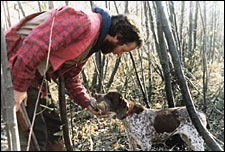 Michel Gelinas accepts a woodcock from Kim, a female Braque Francais. |
One man who read that article and became instantly intrigued was Brad Boisen, a chiropractor from Pine Island, Minnesota. Brad and his wife Julie now operate "Chenil de Grand Ciel" (Kennel of the Big Sky) at their rural home near Pine Island, where they have bred Braques for six years. I traveled to Minnesota to visit the Boisens and observe their dogs in the field.
Finally, I interviewed Phil Knape, a professional trainer of dogs and horses in Michigan. Although no longer active in the breed, Knape raised two litters in the mid-1990s and finished training with seven Braques. As a pro, Knape has trained virtually every breed from Chesapeakes to English setters, so he can compare the Braque Francais to other breeds as few people can.
The insights of these experts will help us to understand the Braque's place on the North American gun dog scene...and what the future may hold for this breed.
HISTORY OF THE BREED
As early as the 14th century, a pointing dog known as the "Chien d' Oysel" was used in the Mediterranean region to point partridge, which were then captured with nets. This dog is believed by many to be the predecessor of the Braque Francais and most other pointing dogs of Europe.
In subsequent centuries, brown- and-white spaniels and pointers came into common use in southwestern Europe. In 1683, a hunter named Selincourt wrote what may be the earliest "breed standard" of sorts. He described the popular pointing dog of the day as "tall in size, strongly built, large-headed with long ears, square muzzle, large nose, hanging lips and a brown and white coat."
This brown and white pointer spread throughout Europe and evolved locally through interbreeding with various dissimilar dogs. By the late 1700s, two types of setter, one spaniel, and one shorthaired pointer had emerged. Although multiple local names existed for the shorthaired pointer, descriptions and illustrations from the period depict essentially the same dog. However, with further provincial separation, more varied physical attributes would later become apparent, even within France. Each new "breed" took on the name of its province. Hence, today we have the Braque d'Auvergne, Braque Saint Germain, Braque du Puis and Braque du Bourbonnais.
After the French Revolution in 1789, mainstream French tastes gravitated toward English dogs. The last remaining stronghold of affection for the old-style French pointer was the Gascogne region in southern France. There, the big brown and white dogs continued to hunt through the 1800s as they had for centuries.
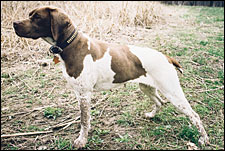 Bridget, a female Braque Francais owned by Phil Knape, points a Michigan pheasant. |
As the 20th century approached, an increasing number of hunters wanted all the attributes of the old-style French Pointer in a smaller package. A 75-pound pointing dog was not ideally suited to life in an urban, industrialized society. Another impetus for reducing the breed's size was the hunting terrain in the Pyrenees Mountains of France. There, a faster dog with tremendous stamina was needed. By breeding the old-style large dogs with smaller shorthaired pointing dogs, a smaller Braque Francais was produced in the Pyrenees region.
By 1920, the divergence of the Braque Francais into two distinct types became a permanent reality. Dr. C. Castets, the first President of Le Club du Braque Francais de France, fancied the larger or "Gascogne" type. The Club's second President, M. B. Senac- Legrange, was a devotee of the smaller or "Pyrenees" type. Today, the Pyrenees type is the more popular of the two. In fact, there has been no known importation of Gascogne type dogs to North America.
The Pyrenees' reduced size is reflected in a different hunting style from that of the Gascogne. Whereas the Gascogne exhibits a slow and methodical movement afield, the Pyrenees is a lithe and leggy dog with nimble feet and a quick, efficient, fluid gait. "They don't sprint when they're hunting," says Brad Boisen, "They glide." This lively but reasonable pace, combined with a sleek physique, enables the Pyrenees to hunt for long periods without fatigue.
The breed is now known by various names, including Gascony Pointer (Gascogne type), Braque Francais de Grand Taille (Gascogne type), Braque Francais de Petite Taille (Pyrenees type), French Pointer and even French Setter. Since the Pyrenees type is the only type currently extant in North America, further reference to the "Braque Francais" in this article will refer only to the Pyrenees type.
TRAITS OF A GOOD ONE
Physical. The Braque Francais is not recognized by the AKC, and the breed's aficionados prefer it that way. There is no such thing as a "bench Braque"--all Braques are field Braques. To date, the major registry for the breed on this continent has been the Canadian Kennel Club (CKC). The other primary registry on this continent is the North American Versatile Hunting Dog Association (NAVHDA). Neither organization has a published breed standard. In France, the breed is registered with the Societe Centrale Canine (SCC).
As long as we're talking about registration, there is one major pitfall that potential buyers should be aware of.
The SCC will not register any dog with common ancestors in the first three generations of its pedigree. In other words, the SCC prohibits linebreeding.
This would have no relevance to North Americans, except for the fact that the CKC will not register any imported dog that cannot be registered in its native country. And failure to acquire CKC registration may create difficulty in gaining registration with NAVHDA. Therefore, be cautious when importing dogs, since unregistered dogs have thus far exhibited a greater tendency toward genetic health problems. By the way, none of the North American registries impose such pedigree restrictions on dogs born in North America. The only requirement is that their parents be registered.
The only detailed breed standard is published by the Federation Cynologique Internationale (FCI), of which neither the United States nor Canada is a member. Generally, the FCI standard is informally accepted on this continent as the de facto standard for the breed.
The FCI standard calls for the Pyrenees dog to stand 18 to 23 inches at the shoulder. This results in a dog weighing 39 to 53 pounds, depending on gender and individual heredity. Phil Knape's dogs were all 40 to 45 pounds--including males. At the Boisens' kennel, the females ranged from 39 to 45 pounds, with males weighing a shade over 50.
Regardless of size, dogs should be taut-skinned, well-muscled and lean, with a short coat that feels slightly silky to the touch. Brown- and-white and brown roan are the acceptable color patterns. Although the standard states the tail is usually docked, it also allows for naturally short or full-length tails, provided that they are "well carried."
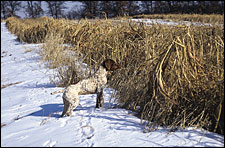 Nourrie, an eight-month-old Braque Francais owned by Brad Boisen, points a pheasant on a Minnesota preserve. |
When I first saw the Boisens' dogs, my initial thought was, "Hey, it's a German shorthaired pointer shrunk down to Brittany size." I'm sure this wasn't the first time the Braque has been mistaken for a GSP, nor will it be the last. The similarities to the GSP are striking, with the most obvious physical difference being size.
Phil Knape noted another physical difference from the GSP. "A Braque's head is shaped more like an English Pointer--not as 'houndy' as the GSP," Knape said.
Thus far the breed has enjoyed relative freedom from genetic health defects. Hip dysplasia and eye defects are quite uncommon, but patella problems have surfaced among a few unregistered dogs. Undershot teeth have also been observed on rare occasion.
Temperament. Brad Boisen describes a proper Braque Francais temperament as "friendly, sociable, gentle and submissive." To illustrate the point, he told an anecdote about his first hunting trip with Cinsault (pronounced SIN-so), an imported male Braque which he acquired in 1994.
"It was my first outing with Cinsault, and I had my two German shorthairs along too," Boisen recalled. The shorthairs took off, running wild, while Cinsault hunted closely and under control. The shorthairs just ignored me as I began to yell at them in progressively louder tones. That's when I noticed Cinsault cowering at my feet. He thought I was mad at him!"
Phil Knape echoed this sentiment. "Most dogs these days are bred to withstand the harsh program that pros use to break strong-willed dogs. That's not what the Braque is bred for."
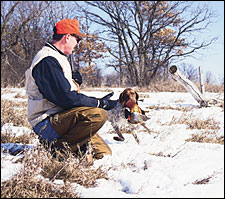 Nourrie delivers a pheasant. |
Julie Boisen noted that the dogs "know their place in the family--you don't have pecking-order problems with them." The Boisens have two children under five years of age, and the dogs take orders from the kids. During our interview, three Braques calmly dozed in various corners of the living room. Brad Boisen mentioned the natural calmness of the breed as a major selling point. "This is a house dog that you can sell to your wife," he said. He speaks from experience.
The breed's sensitivity demands care in training. This is perhaps the primary difference between the Braque Francais and its look-alike counterpart, the German shorthair. The GSP, like most other versatile pointing breeds, has considerable resilience to stern correction. They bounce back quickly from episodes wherein the boss lost his cool. But the Braque requires a more gentle approach.
"Don't bellow at a Braque, or you'll make him a croucher," warns Brad Boisen. He advises that the breed responds better to a "soft hand" approach than to strict discipline.
Phil Knape also notes that Braques mature earlier than other breeds. He said, "I had Braques that were trained and ready to hunt at seven months of age. I had an eight-month-old dog that I used as a guide dog on a hunting preserve. In fact, I could get Braques to do at one year what it took setters two or three years to learn." Nevertheless, it bears reemphasis that these dogs were not brought to such early maturity through accelerated training programs, but through gentle encouragement of their natural responsiveness. Michel Gelinas warns that the breed simply won't tolerate roughness.
For this reason, a word of caution is in order. Although registered and tested primarily with NAVHDA, the Braque Francais probably will not respond well to some of the methods outlined in that organization's famous "Green Book" of training. Although the program in this "NAVHDA Bible" has worked well for generations of wirehairs, pudelpointers, shorthairs and other breeds, it employs rather strict disciplinary measures. Don't try these with a French Pointer.
HUNTING NICHE: WHO SHOULD OWN ONE?
The Braque Francais probably should be classified as a versatile breed. Braques are excellent trackers, and most have an enthusiasm for water. Thus, it appears likely that NAVHDA is the organization holding most promise for the future of the breed in North America, since that organization has the testing structure best suited to showcase all the talents of the breed. But what type of person should own a Braque Francais?
The interviewees suggested that the breed is ideal for the rookie handler who has never owned a gun dog. They develop into satisfactory hunting companions without elaborate training beyond a few basic commands, dummy retrieving and exposure to bird scent. They learn well through simple absorption of field experience. Michel Gelinas said the breed is "born half trained."
Phil Knape agrees. "I've trained about every kind of dog there is," he said, "but I've never seen dogs as easy to train as a Braque Francais." Some of his Braques were naturally steady to wing and shot, requiring no "
breaking."
The most important trait for a Braque Francais owner to possess is sensitivity. If you can't control your temper and cut an honest dog a little slack when he's learning the ropes, don't buy a Braque Francais.
Phil Knape advised that the Braque Francais is a perfect choice for the hunter who intends for his dog to be primarily a house dog and secondarily a hunting dog. He described his as "couch potatoes" who really came alive in the field.
Brad Boisen says the breed is best suited to "the person who wants a family pet and companion, while also being a dependable hunting dog." Most of the dogs Boisen has sold have become full-time house pets in addition to their role as hunting companions.
If you do a lot of hunting in frigid weather or waterfowling in cold water, then there are better dogs for your purposes than a Braque Francais, even among the versatile breeds. The same is true if you're an avid field trialer. Boisen warns that Braques "just don't have the speed and ground coverage necessary for success in trials." Hunting tests are another matter, but more on that later.
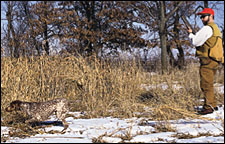 Libby, a young Braque Francais, points a Minnesota pheasant for her owner, Jeff Hjeltness of Menomonie, Wisconsin. |
HOW TO FIND A GOOD ONE
Now comes the hard part. You can't always turn to the classified ads in Gun Dog, make a phone call and buy a Braque Francais. At the present time, the Boisens and Michel Gelinas are the only people on this continent breeding registered Braque Francais on a regular basis. They each produce only one or two litters per year. However, they network with many previous clients, and can often direct you to someone with a one-time litter of puppies from registered parents.
Still, the present gene pool on this continent is not yet large enough to support widespread demand. If the breed is to become ubiquitous in North America while retaining its present quality, more registered dogs must be imported from France to expand and diversify the North American gene pool. At the time of this writing, the Boisens are negotiating the importation of two new dogs from France, which will allow them to satisfy the demand for more puppies, while preserving the essential quality of the breed. Michel Gelinas also continues to import dogs as needed.
Admittedly, North Americans could expedite the proliferation of the Braque Francais by breeding extensively within families. How-ever, true linebreeding is an art practiced only by people who really know what they're doing. Without a programmatic, holistic focus, the result is not linebreeding but mere inbreeding. And that can have disappointing consequences.
A GUN DOG FRONTIER
How rare is the breed here in the New World? Currently, NAVHDA records show only 31 Braque Francais registered with that organization, with Phil Knape and Michel Gelinas being the only breeders with registered litters. CKC records from 1996 through 1998 show only 26 new registrations during that period, all entered by the Boisens or Michel Gelinas. CKC officials estimate that there are probably less than 200 Braque Francais living in North America.
There aren't many frontiers left on the North American gun dog scene. The Braque Francais is one of them. According to NAVHDA records, only two Braques have participated in hunting tests, and both passed the Natural Ability test. No representative of the breed has yet qualified in the CKC's pointing dog field testing program. Only one has entered. To anyone's knowledge, no Braque Francais has ever participated in any dog show, obedience competition or field trial in either Canada or the United States.
This is a breed with potential to fit the needs of the modern hunter in North America. If the foreign name puts you off, then don't call it the Braque Francais. Call yours a "French Pointer" and name him "Jake." But whatever you call it, this breed combines the best attributes of many other breeds into one dog--convenient coat, compact size, calm and biddable temperament, natural ability, early maturity and versatility.
The tiny handful of breeders on this continent are not pros. They are average folks--avid hunters who have not yet become interested in trials or hunting tests. They are dog lovers, not dog campaigners. The breed itself reflects these demographics. Currently, you cannot find a Braque Francais with any sort of North American hunting test title beyond NAVHDA Natural Ability.
But only one thing is lacking for the breed to achieve success in the hunting test arena--experienced, sensitive handlers with test savvy, who understand the breed and are able to bring out its natural talents through structured but gentle training. For such a handler, a rare opportunity exists for a "first" in hunting tests. Although the breed isn't eligible for AKC pointing breed tests (JH, SH, MH), the Braque Francais may participate in NAVHDA testing (NA, UPT, UT) and the CKC Field Dog program (FDJ, FD and FDX).
A growing perception exists in the minds of many Americans that we have ruined much of what we inherited from the old countries. While we have made most breeds better at bird-finding, faster and more stylish in their movement, we also have sometimes made them more difficult for the novice to control.
Phil Knape has witnessed the effects of this transformation firsthand as a pro trainer. He describes "Americanization" of breeds as a process in which strong will is selectively bred in to enhance speed and range, and to provide resilience to strict discipline.
The Braque Francais represents unspoiled raw material "fresh" from the old continent--yet untouched by the American penchant for speed and strong will. But a growing number of hunters are beginning to wonder what it might be like to have a dog that actually wants to do what they tell him to. I've found an answer to that question. He is a French Pointer puppy named "Jake" from Brad and Julie Boisen's kennel, and he is napping by my chair as I type this.
I couldn't resist the call of the frontier!






